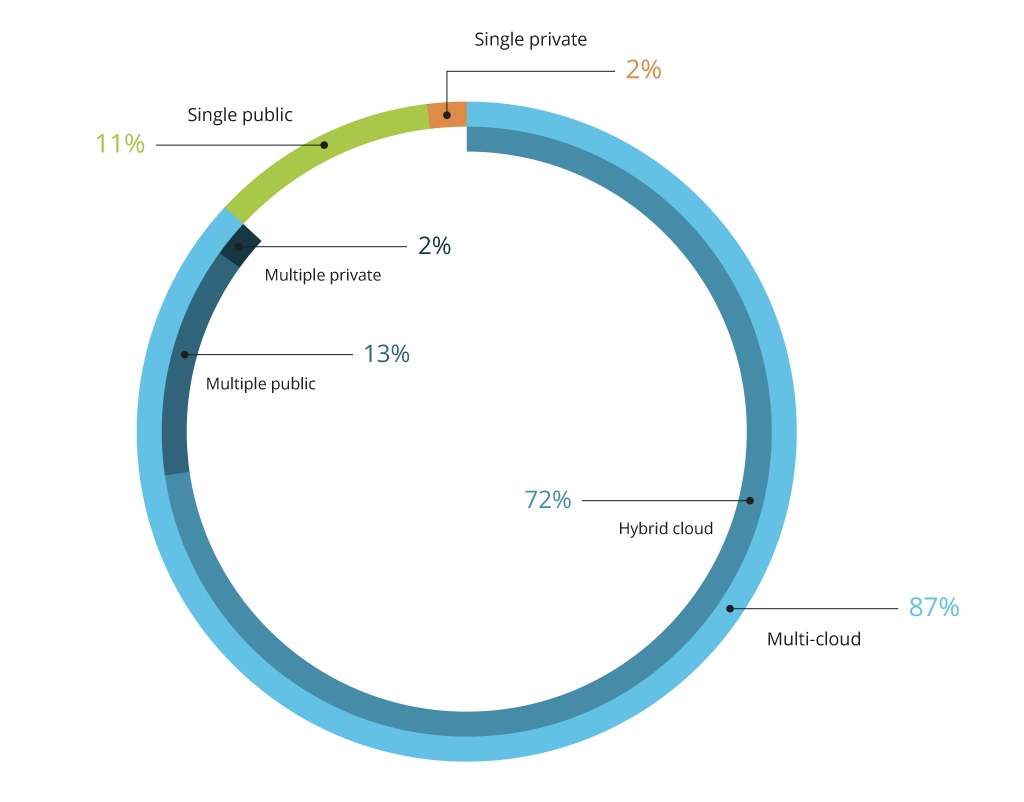Cloud Agnostic vs. Cloud Native Architecture: Which Approach to Choose?
According to a recent report, a multi-cloud approach continues to be popular with organizations: 87% of businesses are now pursuing a multi-cloud strategy, while 72% are adopting a hybrid approach by integrating public and private clouds.
In the light of the comprehensive capabilities that public cloud vendors have developed, this makes complete sense. Google Cloud Platform (GCP) is best known for its advanced infrastructure that supports big data analytics and machine learning projects. Microsoft Azure seamlessly integrates with other Windows products and a wider suite of digital workplace offerings. Amazon Web Services (AWS) has strategically embraced open-source technologies to create a more flexible cloud ecosystem of native and third-party tools for cloud storage, database management, and cloud infrastructure monitoring.
In between are countless other cloud service providers (CSPs), also competing for the growing corporate cloud budgets. However, amidst this abundance of technology, leaders are often pressed with a tough choice: when using a cloud platform, should we develop cloud agnostic architecture or go with a cloud native approach?
In this post, Infopulse cloud consultants have a closer look at cloud native vs. cloud agnostic design strategies to help you make the right choice.
What Is Cloud Native Architecture?
With the advent of cloud computing in recent years, the cloud native approach is gaining popularity. The worldwide cloud native applications market was valued at $5.3 billion in 2022, and it is expected to hit the $48.8 billion mark by 2032, growing at a compound annual growth rate of 25.2% during these years.
In contrast to traditional infrastructure, which is monolithic and often ties applications to specific hardware and environments that companies have, cloud native architecture represents a new trend in application design and deployment, characterized by agility, scalability, and adaptability. Thus, one of the key distinctions from the traditional approach lies in the cloud native ability to effortlessly scale apps across multiple servers or environments, whether in private or public clouds like AWS, Microsoft Azure, or GCP.
The design, development, and delivery of cloud native applications differ significantly from traditional monolithic apps. To be considered cloud native, only running software in the cloud is not enough. The architecture must include four components that play an important role in development: DevOps, microservices, orchestration, and cloud native open standards adoption.
- DevOps. The software development practice ensures continuous delivery, which is integral to delivering cloud native applications. Having operations and developers teams work collaboratively through continuous integration and continuous delivery (CI/CD) creates an environment where software is built, tested, and released faster and more consistently.
- Microservices. Cloud native applications are made of microservices, which implies that a large app is broken down into smaller components. The relative independence of these components allows for more flexibility, faster time-to-market, and scalability of the solution.
- Container orchestration. Cloud native apps are packaged in lightweight containers that allow microservices to run in any environment. This means that containers allow developers to write applications that run across a variety of devices, from smartphones to mainframes, without having to change their code.
- Cloud native open standards adoption. To build such a system, specialists must adhere to the best practices and standards, which provide greater flexibility when, for instance, migrating applications to another cloud provider.
Case in point. One of the largest manufacturing companies in the DACH region partnered with Infopulse to receive comprehensive input on implementing the Microsoft Azure architecture. As a result, Infopulse assisted with the creation of a completely automated process for deploying business logic and infrastructure to Microsoft Azure, along with monitoring and protecting them.
Pros and Cons of the Cloud Native Approach
In addition to its promise of scalability, cloud-native architecture has other advantages. To begin with, it offers the agility to launch new features much faster than the traditional approach and without compromising availability thanks to microservices architecture and containerization. Introducing automation into the software development cycles also significantly accelerates the process. This results in reduced app downtime, cost-effectiveness in development and positively influences user experience.
Cloud native architecture also assumes full reliance on the platform-native toolchain and provides reference architecture patterns. Thus, the development team proactively uses all the premade components and workflows to design applications that are fit to run on a specific platform.
However, cloud native architecture is not the best one when dealing with small applications. Other, more appropriate approaches are advisable, such as the traditional one. Since the cloud native approach can be quite complex and require a lot of time- and human resources, small applications better match with a traditional one that will not introduce unnecessary management overhead and costs. It is often more advantageous for smaller projects to have a monolithic architecture, which allows for faster development, easier debugging, and lower operational costs.
Another disadvantage is that cloud-native architecture has different cloud-bound architectural constraints unique to any specific cloud provider. Although the functional aspects remain the same, the cloud is very different in how it meets non-functional requirements and imposes very different architectural constraints, for example, related to data residency and compliance requirements, container orchestration limitations, and many others. Architects who do not take these variations into account risk creating fragile, costly, and hard-to-maintain systems.
What Is Cloud Agnostic Architecture?
Systems in cloud agnostic architecture do not have any dependencies on a specific cloud provider. Cloud architects design applications in a way that allows them to be ported to any cloud environment with minimum, if any, customization.
Application portability in cloud agnostic architecture is achieved by:
- Using Kubernetes as an abstraction layer between the cloud platform and hosted applications
- Replacing cloud vendor SaaS capabilities with open-source, self-hosted alternatives.
Essentially, your cloud agnostic microservices architecture only relies on a vendor for cloud data storage. Other complementary capabilities — e.g., tools for database management, cloud infrastructure monitoring, resources orchestration, etc. — are deployed as a separate layer and maintained by your company’s engineers, rather than the CSP.
Pros and Cons of Cloud Agnostic Approach
According to a report, 98% of enterprises use or plan to employ a minimum of two cloud providers, which highlights the importance of having cloud-agnostic infrastructure – one that works equally effective with multiple providers.
Cloud agnostic offers exceptional flexibility by allowing for an easy migration of applications between platforms and anywhere in storage space. For example, a CRM system that functions equally well on Microsoft Azure public cloud infrastructure as it also could on AWS or GCP.
With such a flexibility comes the benefit of being vendor neutral. Companies can easily avoid vendor lock-in while taking advantage of unique features and services offered by different cloud providers.
The implementation of the cloud-agnostic architecture also decreases downtime and improves reliability by using multiple cloud platforms that reduce the risk of a single point of failure. For example, in the event of an outage or performance issue with one cloud provider, the workload automatically switches to the other provider, resulting in improved application availability and minimal disruptions for businesses.
However, such an approach can be truly expensive. To develop a cloud agnostic architecture, developers require specific expertise, and other resources, which might be pricy and more time-consuming. Also, cloud agnostic applications may not leverage all the platform capabilities because cloud platforms are designed to specialize in certain areas. For instance, AWS is an excellent choice for many e-commerce businesses thanks to its industry-tailored suite of services. In this case, cloud native architecture is more suitable as it uses the benefits of a specific cloud platform.
Cloud Agnostic Architecture Complexities to Keep in Mind
Weighted selection of the platform stack and subsequent standardization require extra effort. Instead of using the available services, you will have to bring your own solutions for object storage, database management, and resource orchestration.
Cloud infrastructure maintenance is completely on you. Each “block” in your cloud agnostic architecture will require regular updates, patching, and security-proofing.
Security, compliance, and data governance become more complex as you adapt all three processes to different ecosystems.
Establishing a cross-environment Identity and Access Management (IAM) process is challenging because cloud providers implement different IAM strategies.
Cloud Agnostic vs. Cloud Native Architecture: Key Considerations for Adoption
Cloud strategy planning is complex. Whether you are migrating to the cloud for the first time or plan to add another CSP into your technology mix, you must consider:
- Local data centers availability from shortlisted CSPs. Factors like failover, resilience, and latency will depend on the geographic proximity of the data center. Despite positioning themselves as “global”, even the biggest CSPs do not offer full international service coverage.
- Data affinity. For optimal performance, applications must reside close to the data they need. If much of your data is stored in an AWS instance, then it makes more sense to deploy this application on the same platform. Transferring data out of a data center and rehosting it elsewhere usually increases costs without offering many (if any) sizable benefits.
- Security risks. All cloud providers practice a “shared” approach to security. As a customer, you are responsible for implementing proper controls of access management, privileged identity management (PIM), data encryption, and security monitoring. Vendors offer different approaches for implementing baseline cloud security practices, meaning that you have to standardize these across the board.
- Technical maturity. A cloud agnostic approach requires a wider team skillset. You need to have engineers familiar with both specific CSP environments (which differ in small, but crucial ways), as well as a wider range of supporting open-source technologies for cloud orchestration, application management, monitoring, security, and more.
More familiar factors like “deployment costs” and “time-to-market” should also be factored in. If you are switching from one provider to another because of a recent price hike, consider the numbers.
With a cloud native approach, you have low upfront investment, but high switching costs once you get committed to their ecosystem. With a cloud agnostic approach, you face an inverted scenario — high upfront investment, but non-existent switching costs since your systems will remain easily portable to other environments.
The chart below offers a side-by-side comparison of cloud native vs. cloud agnostic operating scenarios:

Ultimately, when deciding on the optimal cloud architecture, mull over the following question: Which approach would offer more value to your business and customers?
Cloud native applications are easier to develop and maintain. However, you are more constrained by the capabilities (and policies) enforced by the selected vendor. In some cases, they might not support data storage in a specific location (for example, to meet GDPR requirements). You may also need to source data from different cloud storage locations as part of a large-scale big data analytics project.
For instance, a group of Hungarian researchers designed a cloud agnostic, fault-tolerant data analytics platform for supporting advanced IoT use cases. The platform contains reusable blocks, made of open-source components, which any other organization can adopt and customize to achieve interoperability between systems.
That said, cloud agnostic systems are harder to manage since you have to establish visibility into multiple underlying cloud components to monitor consumption (and costs). Careful cloud orchestration is also required to ensure proper application performance across live environments.
To sum up the above-mentioned information on cloud native vs. cloud agnostic approaches, both architecture patterns have their merits, but also some unique considerations to account for. Cloud-native is a more straightforward approach. However, it exposes your business to vendor lock-in and underlying platform constraints (e.g., limited regional data center support).
Cloud-agnostic architecture introduces an extra degree of complexity into system design, maintenance, and security. Technology compatibility and standardization issues may also arise and need to be planned for. On the pro side, however, you minimize dependencies on a single vendor and can assemble a more diverse technology portfolio.
When Should Businesses Go Cloud Agnostic?
Cloud agnostic architecture requires high cloud maturity, meticulous planning, and significant upfront investments. It is rarely a strategic choice for new cloud adopters or smaller organizations with a modest cloud estate.
Tech-forward enterprises, however, often gain two significant advantages from choosing a cloud agnostic approach:
- Risk minimization
- Technology choice selection
Cloud agnostic architecture minimizes the risk of vendor lock-in. Your company retains independence on where to place specific workloads in order to better balance costs or ensure the necessary degree of compliance. Mission-critical workloads can also be rapidly migrated to another target environment as part of business continuity planning. In this case, if a CSP experiences a breach or a critical outage, you can rapidly pivot to an alternative platform.
Cloud agnostic architecture also exposes you to a wider range of open-source and proprietary tools for assembling scalable, resilient, and purpose-built systems.
You do not have to compromise on certain applications to ensure the high performance of others. Instead, you can allocate them to different cloud environments and benefit from their native capabilities. That said, open-source cloud solutions are not fully suitable for every industry, as security remains your full responsibility. Likewise, it may be challenging to find an IT vendor who would support a particular open-source cloud technology.
On the other hand, a cloud agnostic strategy exposes you to a wider choice of CSPs and IT vendors who specialize in particular environments. You can shortlist vendors based on their certification status with a CSP. Oftentimes, you can also obtain better license deals as CSPs offer certified vendors attractive discounts.
Does Cloud Agnostic Strategy Fully Exclude Cloud Native Applications?
Cloud native and cloud agnostic architecture patterns are not mutually exclusive and can co-exist within a wider technology strategy.
Cloud native application development has an undeniable advantage in terms of speed. You can iterate on new ideas faster and accelerate time-to-market for innovative customer-facing products.
At the same time, CSPs also recognize the market’s growing affinity for multi-cloud usage. Hence, interoperability between different cloud platforms has been improving. AWS, Microsoft Azure, and GCP offer numerous APIs for building secure data exchange pipelines and automating deployments across environments.
Finally, a new breed of tools is emerging to facilitate multi-cloud connectivity. For instance, Distributed Application Runtime (Dapr) allows companies to use native cloud services without relying on their APIs, Instead, you can set up a custom abstraction layer which facilitates service discovery, observability, and message broker integration, among other aspects. Most importantly, you can focus on creating the optimal business logic for your application without worrying about the specific CSP requirements. Another popular tool is Azure Arc, which enables management of an enterprise's resources across on-premises and multiple cloud platforms, like AWS and Google Cloud.
Therefore, your company can practice a dual approach: Prioritize native cloud architecture for customer-facing products and rely on the cloud agnostic approach for core business systems. In this way, you reduce dependencies on a single cloud provider (and, therefore, optimize risks) without sacrificing the speed of new product development.
Conclusions
CSPs are actively competing for clientele. As the market continues to evolve, more and more companies are drifting towards a cloud agnostic approach. To decide if this option fits your business, analyze your product development plans and overall IT maturity. If fast time-to-market and low infrastructure management overhead are your current priorities, a cloud native approach makes sense. However, if your organization wants to improve its long-term resilience and diversify risks, a cloud agnostic approach can bring in longer-term benefits.
Choosing the right cloud approach can be challenging, but with years of exercise and expertise in cloud migration and management, cloud security, as well as cloud DevOps, and cloud development, Infopulse is well-equipped to help businesses find the optimal cloud solution and adopt the best-suited approach.
![Cloud Native vs. Cloud Agnostic [banner]](https://www.infopulse.com/uploads/media/banner-1920x528-cloud-agnostic-vs-cloud-native-architecture-which-approach-to-choose.webp)








![FinOps: Key Principles and Benefits [thumbnail]](/uploads/media/thumbnail-280x222-cloud-cost-optimization-with-finops.webp)
![Benefits of Cloud-Agnostic Strategy [thumbnail]](/uploads/media/thumbnail-280x222-cloud-agnostic-strategy-whats-in-and-how-to-act-to-get-tangible-business-value.webp)
![Reasons to Choose Cloud-Native Development [thumbnail]](/uploads/media/7-reasons-to-choose-cloud-native-solutions-over-anything-else-280x222.webp)
![Cloud-Native OSS for Telco [thumbnail]](/uploads/media/what-makes-telcos-lean-toward-containerized-cloud-native-oss-promo-baner-280x183.webp)



